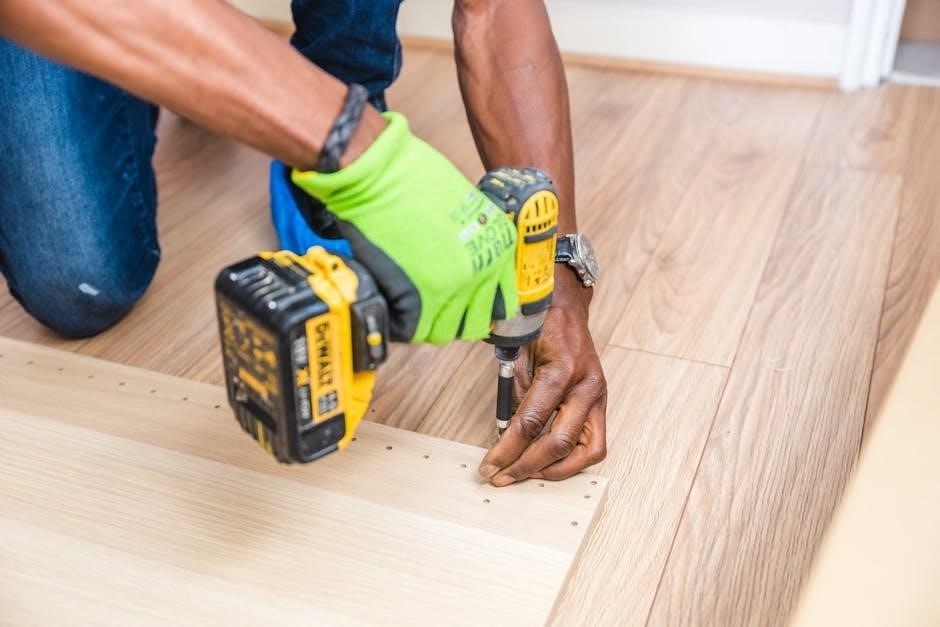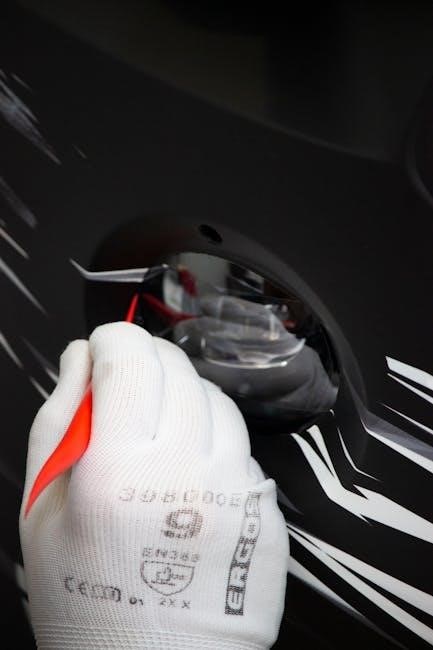Welcome to the SPOA10 Installation Manual, your comprehensive guide for installing and setting up the Rotary SPOA10 two-post lift. This manual provides essential instructions, safety guidelines, and technical details to ensure a successful installation. Proper preparation and adherence to the steps outlined are crucial for optimal performance and safety.
1.1. Purpose and Scope of the Manual
This manual serves as a detailed guide for the installation of the SPOA10 two-post lift, ensuring a safe and proper setup. It is designed for technicians, garage owners, and installers to follow structured steps for successful implementation. The scope includes step-by-step instructions, safety protocols, and technical specifications to guarantee compliance with industry standards. The manual covers pre-installation checks, system requirements, and post-installation testing to ensure the lift operates efficiently and safely. It also addresses common installation challenges and provides troubleshooting solutions. By adhering to this manual, users can achieve a professional-grade installation tailored to their specific needs. This guide is essential for anyone aiming to install the SPOA10 lift correctly and safely.
1.2. Safety Precautions and Warnings

Ensure all safety precautions are strictly followed during the installation of the SPOA10 lift. Always wear protective gear, including safety glasses and gloves, to prevent injuries. Never exceed the lift’s weight capacity, as specified in the manual. Conduct regular inspections of components like screws, chains, and anchors before and after installation. Use safety stands when working under the lift or removing heavy parts. Avoid installing the lift outdoors, as it is designed for indoor use. Properly anchor the lift to the floor to prevent instability. Follow all lockout/tagout procedures when servicing the lift. Failure to adhere to these guidelines may result in serious injury or equipment damage.

System Requirements and Compatibility
The SPOA10 lift requires a reinforced concrete slab of at least 4-6 inches thick, proper electrical power supply, and stable floor anchoring to ensure safe operation and compatibility with your facility.
2.1. Space and Facility Requirements
Ensure your facility meets the necessary space requirements for the SPOA10 lift installation. The lift requires a minimum ceiling height of 12 feet to accommodate the upright columns and lifting arms. The floor must be level, even, and free of cracks to ensure stability. A reinforced concrete slab with a minimum thickness of 4 inches and a compressive strength of 3,000 PSI is recommended. The installation area should be clear of obstructions, with at least 3 feet of space around the lift for safe operation and maintenance. Additionally, the floor should be anchored securely to prevent movement during use.
2.2. Concrete Slab Specifications
The SPOA10 lift requires a reinforced concrete slab with a minimum thickness of 4 inches and a compressive strength of 3,000 PSI. Ensure the slab is level within 1/4 inch over 10 feet and cured properly. The surface must be clean and free of cracks or debris. For anchor installation, the concrete should be at least 28 days old. A professional inspection is recommended to verify slab suitability. Additionally, ensure the slab can support the lift’s weight and any vehicle loads. Proper slab preparation is critical for safety and stability during operation. Always follow manufacturer guidelines for concrete specifications.
2.3. Electrical and Power Supply Needs
The SPOA10 lift requires a dedicated 220V, 60Hz electrical supply with a minimum of 20 amps. Ensure the power source is stable and meets local electrical codes. Use 12-gauge copper wire for connections to avoid voltage drop. The lift must be grounded properly to prevent electrical hazards. Install a main disconnect switch near the lift for easy access. Avoid using extension cords or shared circuits. Verify the power unit model (E or S) to ensure compatibility with your electrical setup. Outdoor installation is not recommended due to potential damage from environmental factors. Always consult a licensed electrician for wiring to guarantee safety and compliance with regulations.
2.4. Floor Anchoring and Stability
Proper floor anchoring is critical for the safe and stable operation of the SPOA10 lift. The concrete slab must be at least 4 inches thick, with a compressive strength of 3,000 PSI or higher. Ensure the floor is level and free of cracks. Use the provided anchor bolts to secure the lift to the concrete, spaced evenly according to the manufacturer’s specifications. For the SPOA10 model, anchors should be embedded 12 inches deep to ensure maximum stability. Tighten all bolts to the recommended torque specification to prevent any movement during operation. Failure to anchor correctly may result in uneven lift performance or safety hazards. Always follow the installation guide for precise measurements and torque requirements.
Pre-Installation Steps
Begin by preparing the site, conducting safety checks, and gathering all necessary tools and materials. Ensure the area is clear and inspect the lift components for damage.
3.1. Site Preparation and Safety Checks

Before starting the installation, ensure the site is properly prepared. Clear the area of debris and obstructions to allow unobstructed access. Verify the concrete slab meets specifications, including thickness and strength. Conduct a visual inspection for cracks or unevenness. Check the floor for proper drainage to prevent water accumulation. Ensure all necessary safety equipment, such as jack stands and safety glasses, is available. Perform a final walk-through to confirm the space is safe for installation. Address any potential hazards, such as loose flooring or unstable structures, before proceeding. Proper site preparation ensures a smooth and secure installation process for the SPOA10 lift.
3.2. Tools and Materials Needed

Before starting the installation, ensure you have all necessary tools and materials. Essential tools include an impact wrench, socket set, torque wrench, and measuring tape. Required materials are anchor bolts, concrete anchors, and a leveling kit. Safety equipment like gloves and safety glasses is mandatory. Additional items include a drill with concrete bits, a spirit level, and lubricants for moving parts. Ensure all components from the lift kit are accounted for, and refer to the inventory list provided. Proper preparation prevents delays and ensures a smooth installation process. Gather all items in a centralized workspace for easy access.
3.3. Understanding the Lift Components
Before starting the installation, it’s crucial to familiarize yourself with the SPOA10 lift components. The system includes two columns, lift arms, a screw-driven carriage, and a chain system. The columns provide structural support and house the lifting mechanisms. The lift arms attach to the vehicle and are adjustable to accommodate various vehicle widths. The screw and chain system ensures smooth and precise vertical movement. Additionally, the power unit, control panel, and safety locks are integral for operation and security. Understanding these components ensures proper installation, safety, and functionality. Refer to the diagrams in this manual for detailed visual identification and descriptions of each part.
Installation Process
Begin with unboxing and inventorying all parts. Install anchors, ensuring proper alignment and stability. Assemble main components, aligning screws and chains precisely. Conduct final testing and adjustments, ensuring even load distribution and safety. Use safety stands as needed during installation to prevent accidents and ensure a secure setup. Follow all instructions carefully for a smooth process.
4.1. Unboxing and Inventory of Parts
Begin by carefully unboxing all components of the SPOA10 lift, ensuring no damage occurred during shipping. Conduct a thorough inventory to verify all parts are included, such as the lift columns, cross beams, lift arms, anchor bolts, and hardware. Refer to the provided parts list to confirm quantities and identify each component. Inspect for any visible damage or defects and contact the supplier immediately if discrepancies are found. Organize the parts in a logical manner to streamline the installation process. Always use safety stands when handling heavy components, and ensure the area is clear of obstructions. Proper organization and verification are critical for a smooth installation.
4.2. Anchor Installation and Alignment
Proper anchor installation is critical for the stability and safety of the SPOA10 lift. Begin by using the provided template to mark anchor locations on the concrete floor, ensuring precise alignment. Drill pilot holes to the specified depth, then insert the anchors securely. Tighten the bolts evenly to avoid misalignment. Use a spirit level to verify that all anchors are perfectly aligned and the lift base is level. If the concrete slab has cracks or imperfections, consult the manual for repair recommendations before proceeding. Always ensure the floor meets the specified load-bearing requirements to prevent instability. Safety stands should be used during the alignment process to support the lift arms temporarily. Proper alignment ensures smooth operation and prevents potential damage to the lift or vehicles.
4.3. Assembling the Main Lift Components
Begin by assembling the main lift components, ensuring all parts are properly aligned and securely fastened. Attach the lift columns to the floor anchors, verifying they are level and plumb. Install the lift carriage, connecting it to the columns using the provided hardware. Next, attach the lifting arms to the carriage, ensuring they are evenly spaced and aligned. Use safety stands to support the components during assembly. Tighten all bolts according to the torque specifications provided in the manual. Double-check the alignment of all parts before moving on to the final adjustments. Proper assembly is critical for safe and efficient operation of the SPOA10 lift.
4.4. Final Adjustments and Testing
After assembling the lift, perform final adjustments to ensure all components are properly aligned and secured. Tighten all bolts and screws according to the torque specifications provided. Conduct a thorough safety check, including testing the lift’s emergency stop function and ensuring smooth operation. Load test the lift with the maximum rated capacity to verify stability and performance. Check for any unusual noises or vibrations, addressing them immediately if detected. Once all tests are passed, calibrate the lift arms and safety locks to ensure precise operation. Finally, document the installation and testing results for future reference and maintenance planning.

Post-Installation Checks
Verify lift safety, conduct load testing, and calibrate components. Inspect for wear and ensure proper function. Schedule regular maintenance to maintain optimal performance and safety standards.
5.1. Safety Verification and Load Testing
Safety verification and load testing are critical final steps after installation. Ensure all components are securely anchored and aligned. Perform a visual inspection of wires, chains, and hydraulic systems. Test the lift with the maximum rated weight to confirm stability and proper function. Use safety stands during initial testing to prevent accidents. Check for even load distribution to avoid imbalance. Refer to the manual for specific load testing procedures. Failure to follow these steps can result in equipment damage or safety hazards. Always prioritize caution to ensure reliable operation and user safety.
5.2. Calibration and Fine-Tuning
After installation, calibration ensures the SPOA10 lift operates smoothly and safely. Begin by ensuring the lift is on a level surface and all safety locks are engaged. Use the provided calibration tools to adjust the lift arms and synchronize the columns. Fine-tune the height and alignment to meet specific vehicle requirements. Test the lift by raising and lowering it to confirm even movement and proper leveling. If necessary, adjust the hydraulic system or electrical controls for precision. Refer to the manufacturer’s guidelines for detailed calibration steps and troubleshooting common issues. Always test the lift with a vehicle to ensure stability and functionality before regular use.
5.3. Documentation and Maintenance Schedule
After installation, maintain detailed records of inspections, repairs, and maintenance for the SPOA10 lift. Schedule regular checks of critical components, such as hydraulic systems, cables, and anchors, to ensure safety and performance. Refer to the manual for specific maintenance intervals. Keep a log of all servicing activities, including dates and procedures performed. Store the installation manual and maintenance records in an accessible location for future reference. Regular lubrication of moving parts and inspection of wear items, like lift arms and screws, is essential. Always follow the manufacturer’s guidelines to prolong the lift’s lifespan and ensure compliance with safety standards.

Troubleshooting Common Issues
This section addresses common issues during SPOA10 installation, such as alignment problems or uneven lifting. Check for loose components and ensure proper hydraulic connections for smooth operation.
6.1. Addressing Installation-Related Problems
During the installation of the SPOA10 lift, common issues may arise, such as uneven floor surfaces or misaligned anchors. First, ensure the concrete slab meets specifications and is level within 1/2″. If the floor is uneven, break out and repour as needed. Check anchor alignment carefully to avoid lift instability. For hydraulic or mechanical malfunctions, inspect hoses, cylinders, and chains for damage or wear. Always use safety stands when testing or adjusting heavy components. If issues persist, consult the manual or contact Rotary support for assistance. Proper troubleshooting ensures safety and optimal performance of the SPOA10 lift system.
